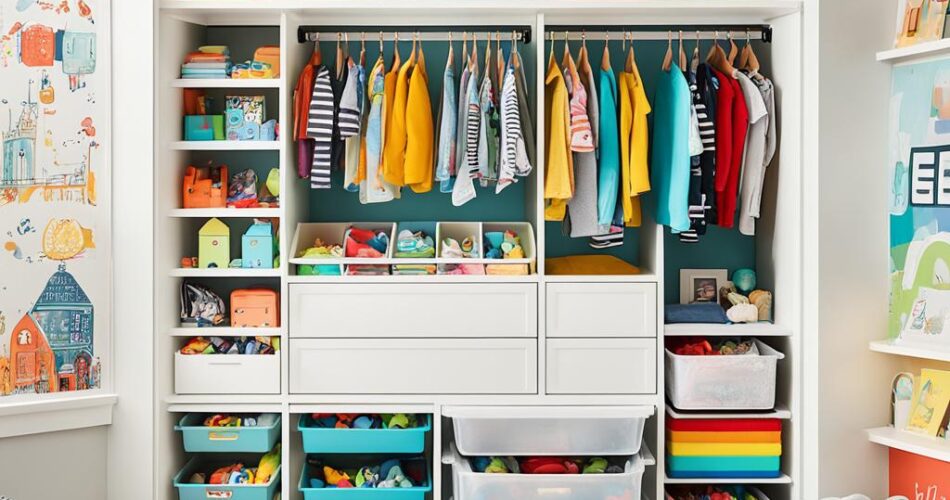Is your child’s room a mess of toys and clothes? You’re not alone. Many parents struggle to keep kids’ rooms tidy. Let’s explore some kids room organization tips to turn chaos into calm.
Decluttering kids’ spaces is the first step. Begin by sorting items into groups. This approach helped one family clear their floor in a week. They put toys into categories like trains, cars, and art supplies.
Creating functional play areas is crucial. Think about furniture with built-in storage. Beds with drawers or dressers with shelves can make a big difference in small rooms. For toy storage, consider hanging baskets from the ceiling or attaching bins to walls.
Organizing kids’ clothes and books doesn’t have to be hard. Use bins in the closet and set up an art corner for magazines and coloring books. Remember, it’s better to have a few quality items than many low-quality ones.
Getting your kids involved in organizing teaches them important skills. Plus, you might find forgotten treasures, like those Christmas toys from months ago!
The Importance of an Organized Kid’s Room
An organized kid’s room is more than just clean. It’s a key to growth, learning, and being independent. Keeping a child’s room tidy affects their daily life and growth.
Benefits of a Clutter-Free Space
Having a clean room has many perks. Kids in tidy spaces learn better self-control. Minimalist designs in kids’ rooms make for a peaceful place. This leads to better sleep and less stress.
Impact on Child’s Productivity and Mood
Research finds that kids act more organized when their space is tidy. A simple, clean room boosts focus and creativity. Happy kids live in well-kept rooms and work better together.
| Activity | Time Spent | Benefit |
|---|---|---|
| Daily Tidy-up | 15 minutes | Maintains organization |
| Weekly Declutter | 30 minutes | Prevents accumulation |
| Monthly Room Review | 1 hour | Ensures functional space |
Creating Functional Living Areas
It’s key to make clear areas for sleeping, dressing, playing, and studying. This helps kids know where things go. It also teaches them to keep their space tidy.
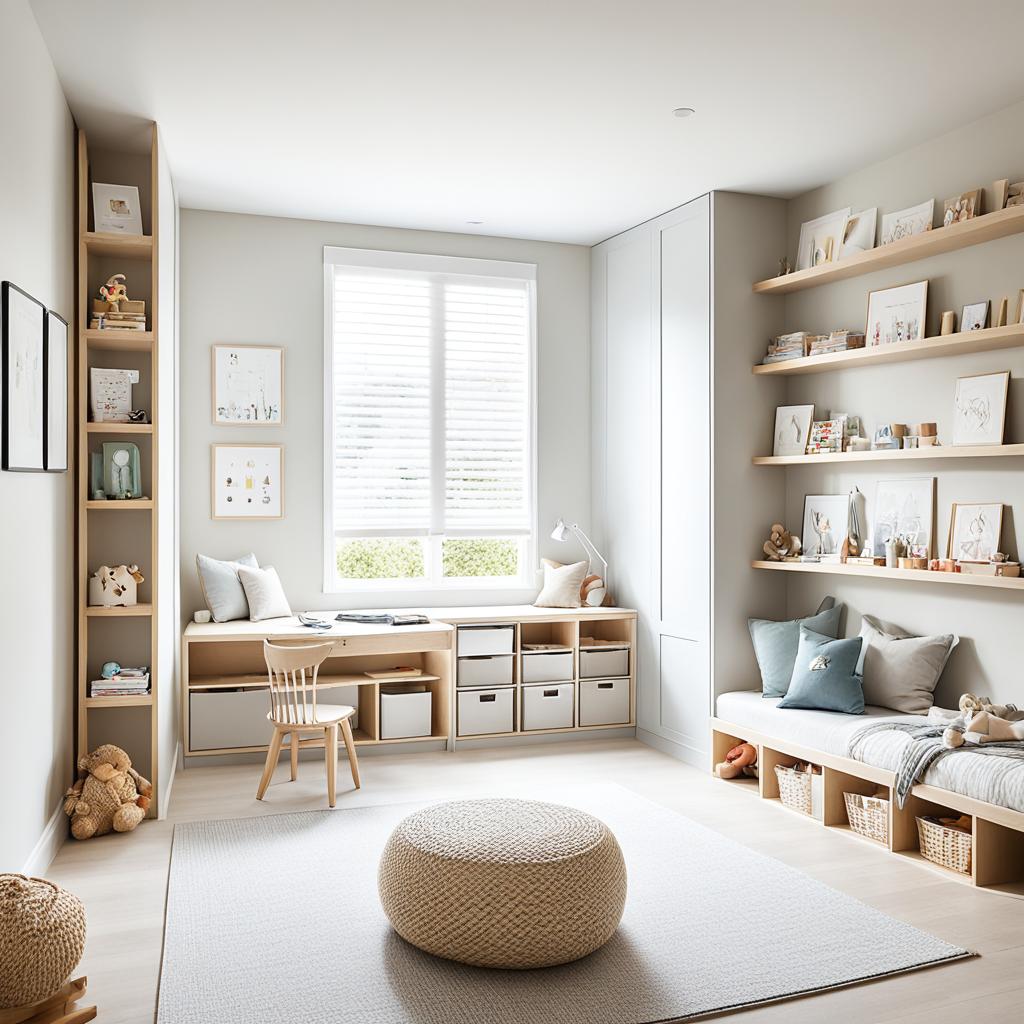
Changing a kids’ room to be organized can make it a caring place. Using smart storage and letting kids help makes a room that grows with them. It encourages responsibility and creativity.
Start with a Clean Slate: Decluttering Strategies
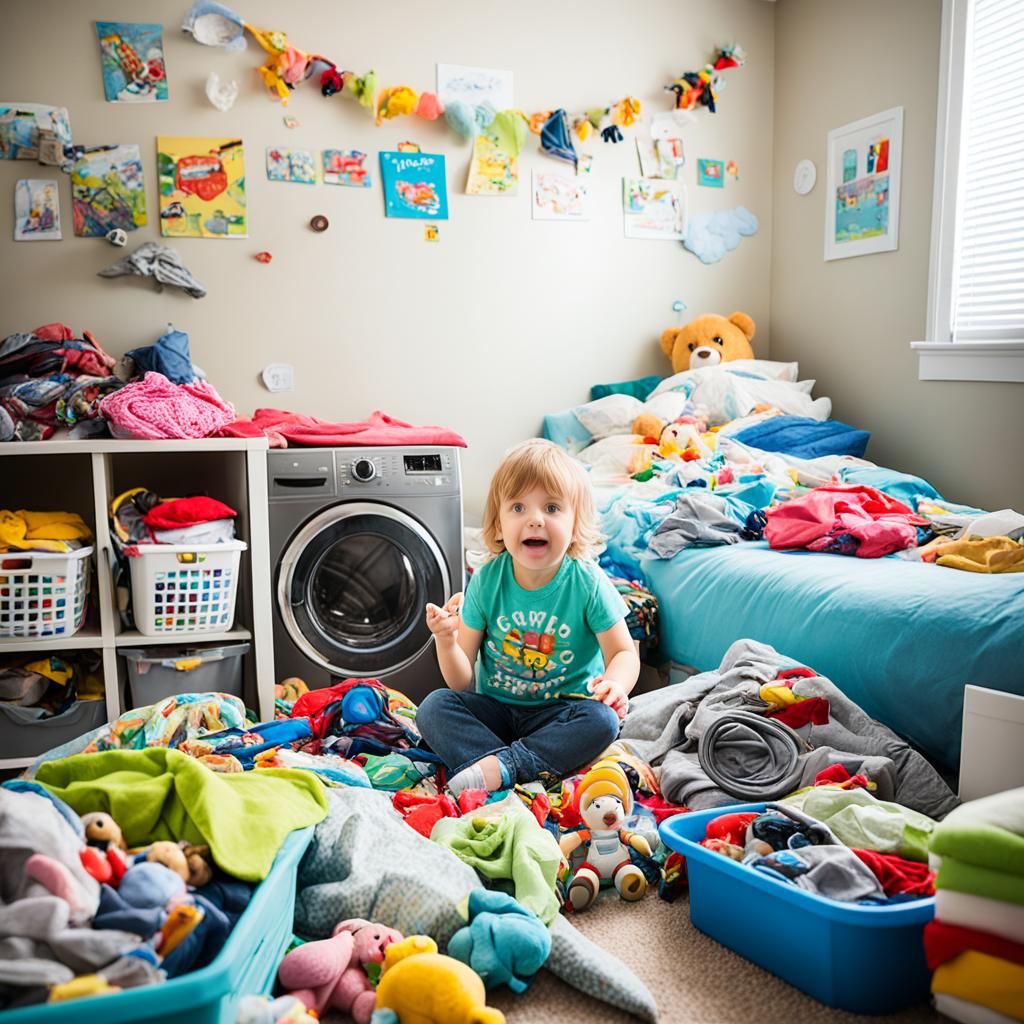
Decluttering kids’ rooms can feel overwhelming, like tackling a hoarder’s space. But don’t worry! With the right strategies, you can turn your child’s room into a tidy oasis. Start by removing everything from the room to begin fresh.
Begin by sorting items into categories: toys, clothes, and books. This makes it easier to see what you have. Get your children involved in deciding what to keep, donate, or discard. Be strict in getting rid of unused items, broken toys, and outgrown clothes.
Try these tips for organizing children’s bedrooms:
- Set a timer for 5, 10, or 15 minutes to make cleaning sessions manageable
- Turn decluttering into a game to motivate kids
- Use a chore chart with rewards to encourage participation
- Celebrate successes to boost morale
Adopting a minimalist approach to kids’ possessions can greatly help. Regular upkeep is key to keeping the space clutter-free. Spend a few minutes each day tidying up. If it feels too much, consider local cleaning services for extra help.
Decluttering is an ongoing process. By using these strategies, you’ll create a fresh start and make organizing easier. Your child’s room will soon become a place they enjoy spending time in.
Kids Room Organization Tips: Essential Techniques
Organizing a kid’s room can be fun and rewarding. With the right techniques, you can make a space that’s both useful and fun for your child. Let’s look at some key strategies to keep your child’s room tidy and organized.
Sorting Items by Category
Begin by sorting items into groups. This helps in finding and putting away things easily. Put toys, clothes, and school stuff in separate piles. Let your child help with this. It teaches them how to organize and gives them a sense of their space.
Implementing Storage Solutions
Smart storage is crucial for keeping things in order. Use bins that are easy to open for things you use a lot. For items you don’t use often, consider under-bed storage. Adding a second hanging rod in the closet is great for clothes and works well in shared rooms.
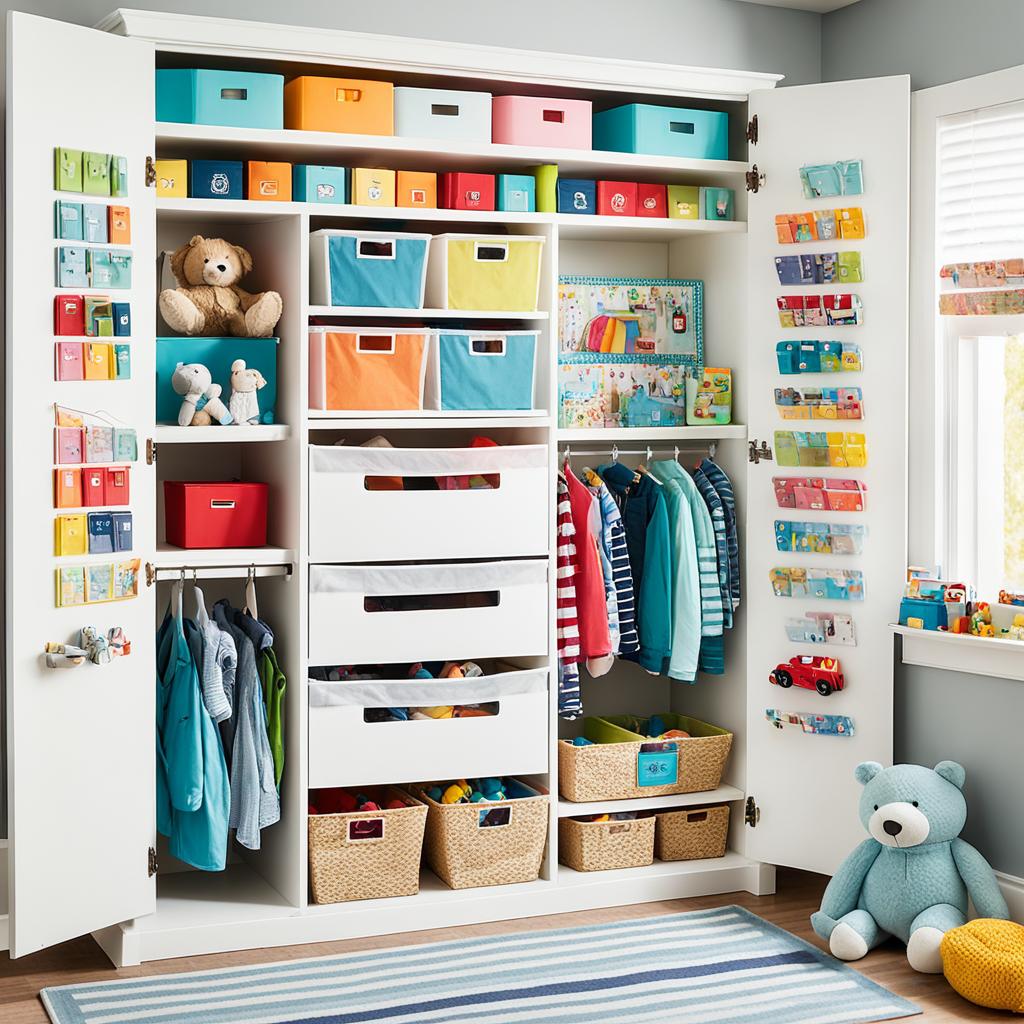
Creating Designated Zones
Make different areas for different activities. This helps kids know where things go. Set up zones for play, study, and rest. Use furniture to mark these areas. A desk for homework, a cozy reading spot, and a play area keep the room tidy and useful.
| Zone | Purpose | Organizing Hack |
|---|---|---|
| Play Area | Fun and creativity | Use labeled bins for toys |
| Study Zone | Homework and learning | Install floating shelves for books |
| Sleep Space | Rest and relaxation | Utilize under-bed storage |
It’s important to involve your child in organizing. It teaches them important skills and makes them proud of their space. With these tips, you’ll make a room that grows with your child and stays organized for a long time.
Maximizing Space in Small Bedrooms

Small bedrooms can feel cramped, but smart ideas can make them functional and organized. Let’s look at some clever tricks for making the most of kid’s room space and keeping it clutter-free.
Vertical storage is key for efficient closet organization. Tall shelving or wall-mounted storage helps free up floor space. It’s great for storing clothes, shoes, and big items that you don’t use often.
Think about swapping out traditional dressers for hanging storage and drawers. This can greatly reduce clutter and give more room for play. Custom built-in storage not only saves space but also looks good in the room.
- Utilize under-bed storage for hidden organization
- Opt for twin beds to free up more floor space
- Use storage bins for shoes and accessories
- Remove closet doors to create an illusion of more space
Loft beds with desks or pull-out workspaces are great for combining sleep and study areas. For a budget-friendly choice, consider a corner desk with shelves. This makes use of spaces that are often ignored.
Bright, neutral colors can make small rooms look bigger and more open. Add color and texture with decor to make the space your child’s own. With these tips, you’ll have a well-organized and spacious bedroom your child will adore.
Creative Storage Ideas for Toys and Books
Keeping a kid’s room tidy can be tough. Toys and books can spread out everywhere. Here are some smart ways to store them, making your child’s space neat and organized.
Utilizing Vertical Space
Use your walls with floating shelves or hanging nets. They’re great for books and stuffed animals. About 60% of the time, shelves help keep toys off the floor.

Multi-functional Furniture Options
Choose furniture that stores more than one thing. Ottomans and bookcases with toy bins are smart picks. They look good and keep toys out of sight.
DIY Storage Solutions
Try making your own storage for your kid’s room. Pegboards are great for art supplies, and crates can be cute book spots. These ideas are both fun and useful.
| Storage Solution | Percentage of Families Using | Benefits |
|---|---|---|
| Baskets | 70% | Versatile, easy to move |
| Shelving | 60% | Maximizes vertical space |
| Under-bed Storage | 40% | Utilizes unused space |
| Color-coded Systems | 30% | Simplifies clean-up |
For good toy storage, be consistent. Use a toy rotation to keep things fresh. With these tips, say goodbye to clutter and hello to a tidy kid’s room.
Organizing Kids’ Clothes and Closets
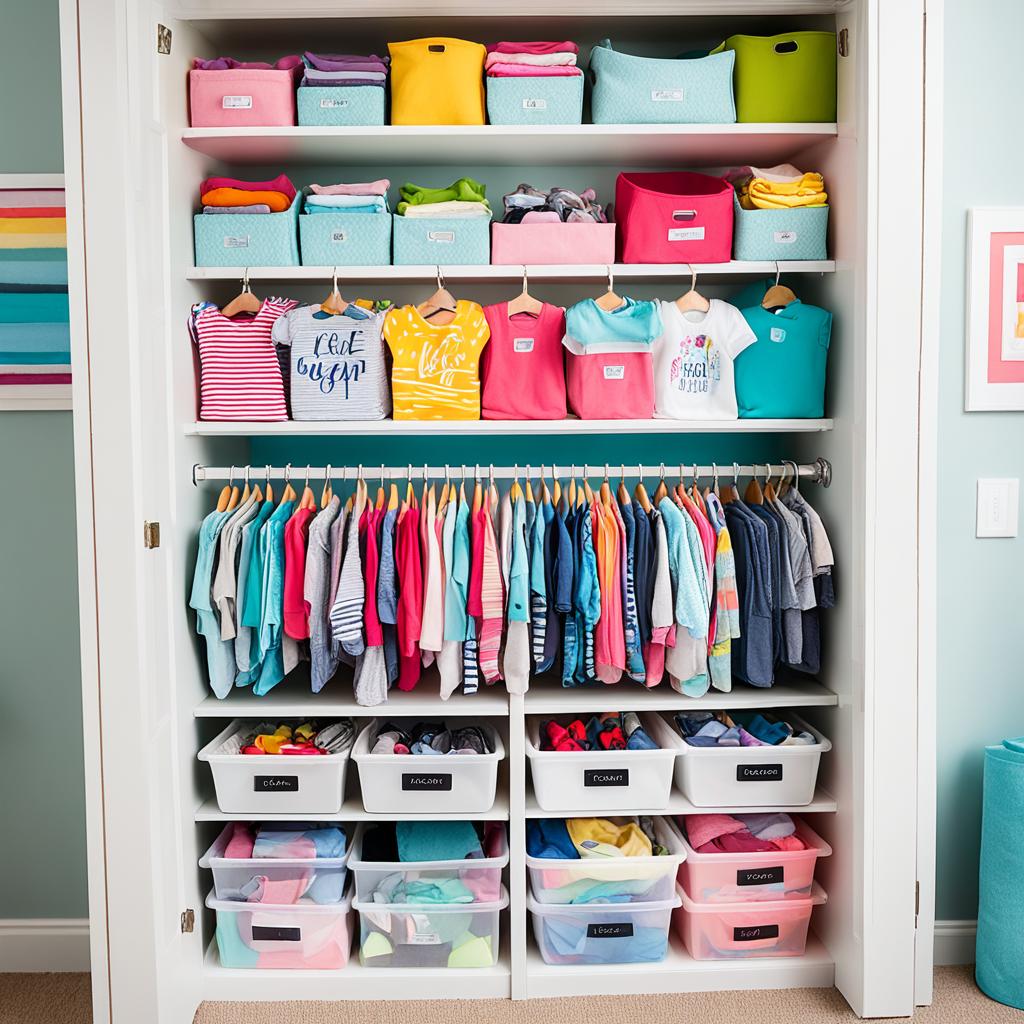
Managing kids’ clothing can be tough. With constant size changes and limited space, it’s key to have smart strategies. Let’s look at ways to organize kids’ clothes and make the most of closet space.
Dressers are often better than closets for storing kids’ clothes. They make folding and sorting simpler. When organizing, sort by body part, season, or type. This approach works for all ages and places.
Use fabric organizers to split clothes into smaller groups. This keeps things tidy and easy to find. For folding, stick to simple methods. It’s faster and better for everyday use.
Get kids involved in keeping dressers tidy. Young ones can put away socks, and older kids can handle drawers. It teaches them important organizational skills.
For hand-me-downs, set up a smart storage plan. Sort carefully, use the right storage, and make sure things are easy to get to. Under-bed bins are perfect for storing next season’s clothes.
| Storage Solution | Best For | Cost |
|---|---|---|
| Hanging Cubbies | Shared Rooms | Under $10 |
| Clear Storage Bins | Size Categorization | Varies |
| Dresser Labels | Non-readers | Free (Printable) |
In shared rooms, hanging cubbies are a big help for organizing closets. For those who can’t read, dresser labels are a good choice. These easy tools can change how you manage kids’ clothes, making things more organized and less stressful.
Creating a Functional Study Area
Setting up a dedicated study space is key for kids to do well in school. Parents now see the value of organizing kid’s study areas. Let’s look at how to make a good study spot for your child.
Essential Elements of a Study Space
A well-thought-out study area helps kids focus and be productive. You’ll need a comfy desk, an ergonomic chair, and good lighting. Creating study spaces that show off your child’s style makes learning fun. Think about adding a bulletin board for notes and a calendar for keeping track of homework.

Storage for School Supplies
Good storage is crucial for managing kids’ school supplies. Use desk organizers, floating shelves, or rolling carts to keep things neat. Label containers so it’s easy to find what you need. This keeps kids organized and lowers stress while studying.
Minimizing Distractions
Minimizing distractions is important for focused studying. Put the desk in a quiet spot away from where people walk by. Keep toys or electronics out during study time. Noise-cancelling headphones can also help block out distracting sounds. By making a focused space, you’re helping your child develop good study habits.
| Study Space Element | Benefits |
|---|---|
| Ergonomic Chair | Improves posture, reduces fatigue |
| Proper Lighting | Reduces eye strain, enhances focus |
| Organized Storage | Increases efficiency, reduces clutter |
Involving Children in the Organization Process
Getting kids to help organize their rooms is crucial for teaching them to be organized. When they help out, they learn important skills and feel proud of their space. Let’s look at ways to get kids involved and make it fun!
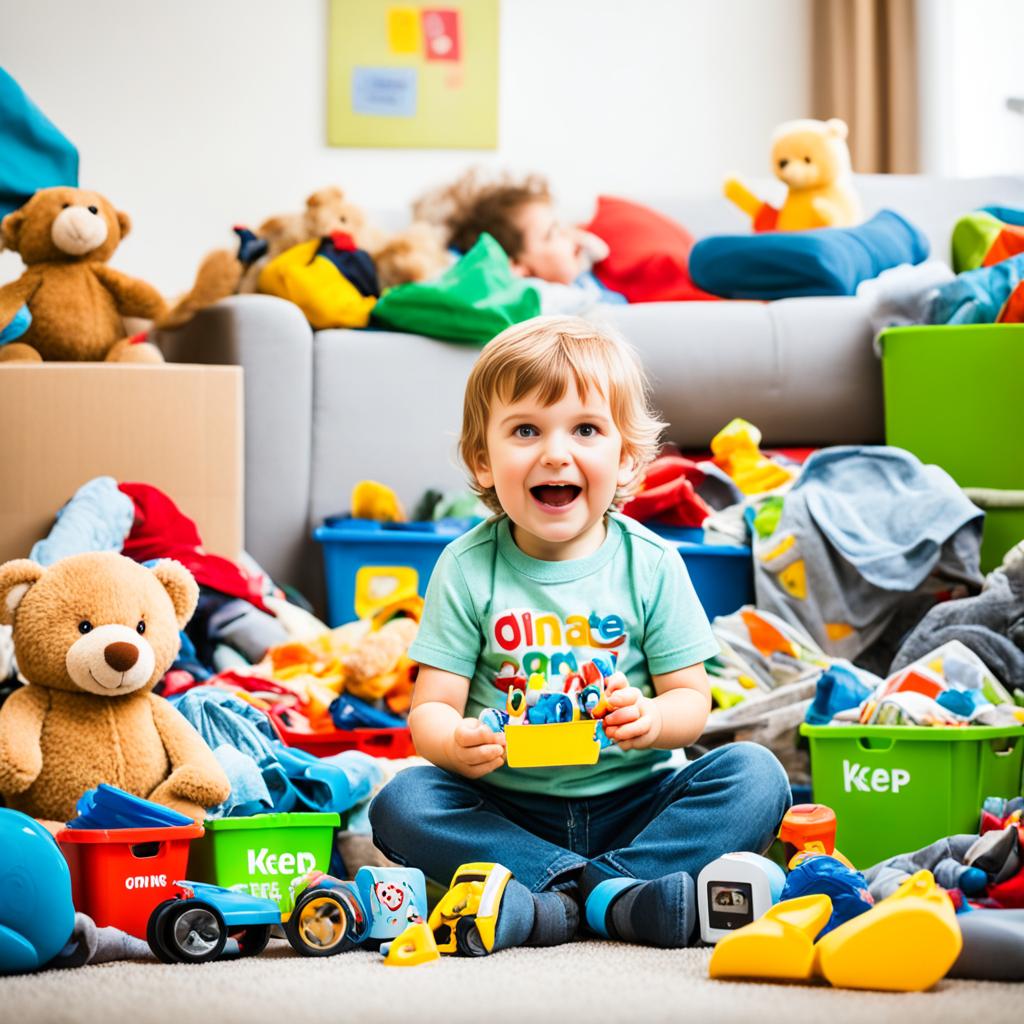
Begin by letting your child decide what to keep or discard. This gives them power and helps them make choices. Use boxes marked “Keep,” “Donate,” and “Toss” for sorting. Guide them, explaining why some items go in each box.
Showing them how to organize is a great way to teach. Demonstrate how to fold clothes, arrange books, and store toys. Turn it into a game by seeing who can put things away the fastest or find the best storage spots.
To keep their room tidy, use chore charts for kids. These charts show what they need to do and help them stick to a routine. Here’s an example of a chore chart:
| Day | Task | Reward |
|---|---|---|
| Monday | Make bed | 5 minutes extra screen time |
| Wednesday | Put away toys | Choose dinner menu |
| Friday | Sort laundry | Special dessert |
| Sunday | Tidy bookshelf | Family game night |
Remember, be patient when teaching kids to organize. Praise their efforts and small wins. With time and effort, these habits will become easy for them, helping them succeed later on.
Maintaining an Organized Kid’s Room
Keeping a child’s room tidy can be tough, but it’s doable. A tidy space can lower stress and anxiety in kids by up to 20%. Let’s look at some ways to keep your kid’s room organized.
Establishing Daily Routines
It’s key to have a cleaning schedule for kids’ rooms. Just 15 minutes a day of organizing can cut clutter by 40% in a month. Start with a quick 10-minute tidy before bed. Give kids their own chores, like making the bed or putting away toys, to help them keep the room clean.
Regular Decluttering Sessions
Have regular decluttering times to stop clutter from building up. Sort donations before holidays or birthdays to handle new items well. Let kids help sort toys to teach them about decluttering. Clothes often cause the most clutter, so focus on organizing them too.
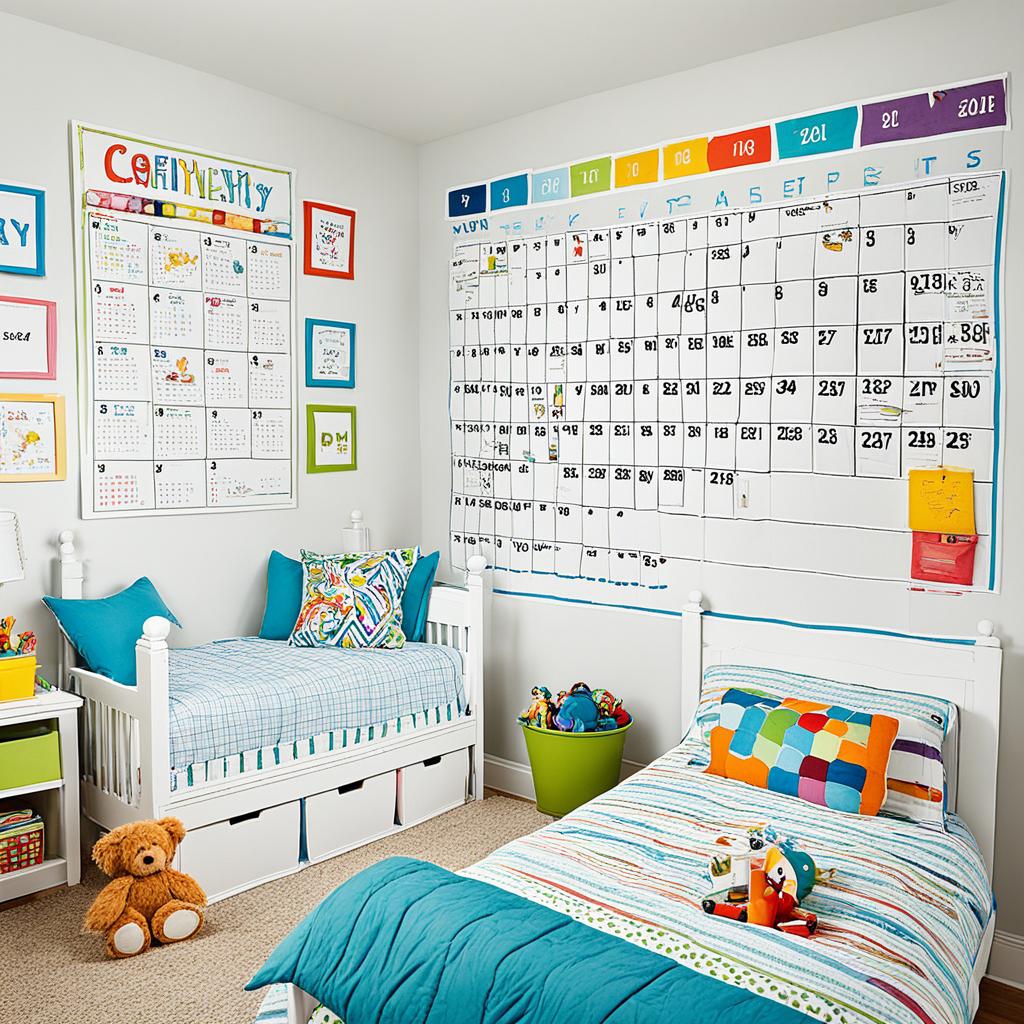
Teaching Organizational Skills
Show good habits and praise kids for keeping their space tidy. Use storage that’s easy for kids and labels to help them remember where things go. Group and categorize items for easier management. Teaching kids about tidiness helps them keep their space organized for a long time.
| Task | Frequency | Impact |
|---|---|---|
| Quick tidy-up | Daily | Prevents clutter buildup |
| Decluttering session | Monthly | Reduces overall clutter by 40% |
| Organize surfaces | Weekly | Creates a calmer atmosphere |
| Update storage systems | Annually | Adapts to child’s changing needs |
By sticking to these tips and being consistent, you can make your child’s room a peaceful and organized place. This helps them stay independent and focused.
Kid-Friendly Labeling and Color-Coding Systems
Making tidying up fun and easy for kids is key to keeping rooms neat. Using labeled storage and color-coding helps a lot. It makes it simple for kids to know where things go, making clean-up quick.
Color-coding is great for organizing. Each child gets a special color for their stuff, like toothbrushes and backpacks. This stops mix-ups and fights in families with many kids. For clothes, sorting them by color makes picking outfits easier and shows what’s missing.
Labeling bins and baskets is also important. Young kids do well with picture labels, while older kids like word labels. Clear bins with labels help kids see and find their things easily. This is super helpful for kids with ADHD, who often find organizing hard. About 70% of parents with ADHD kids say keeping a tidy room is tough.
With these methods, parents can make a space that’s organized and stress-free. These systems don’t just keep rooms clean. They also teach kids important skills for staying organized throughout their lives.
